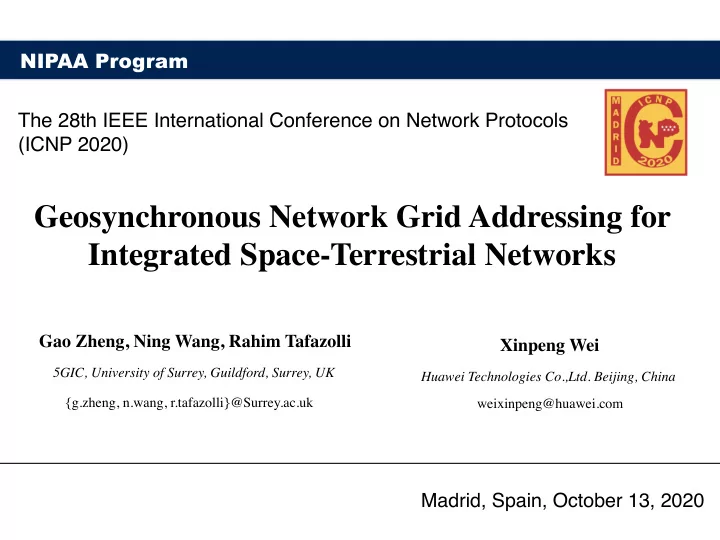

NIPAA Program The 28th IEEE International Conference on Network Protocols (ICNP 2020) Geosynchronous Network Grid Addressing for Integrated Space-Terrestrial Networks Gao Zheng, Ning Wang, Rahim Tafazolli Xinpeng Wei 5GIC, University of Surrey, Guildford, Surrey, UK Huawei Technologies Co.,Ltd. Beijing, China {g.zheng, n.wang, r.tafazolli}@Surrey.ac.uk weixinpeng@huawei.com Madrid, Spain, October 13, 2020
Geosynchronous Network Grid Addressing for Integrated Space-Terrestrial Networks Outline Background The Geosynchronous Network Grid Addressing scheme • The basic idea. • Design details. • Networking with the GNGA scheme. Performance eveluation Conclusion
Background Space-Terrestrial network integration • Networking with Low Earth Orbit (LEO) satellites has received increasing attentions in recent years. The Key challenge • Satellite-terrestrial routing stability different problem. subnets Recent attempts • Satellite as an independent network. • Satellite as the access network. • Satellite as the transit network.
The Geosynchronous Network Grid Addressing scheme The Goal • Seamlessly integrate the space and terrestrial networks based on a unified common IP infrastructure. • Without introducing severe routing stabilises caused by the LEO satellite constellation behaviours. • Especially considering the legacy routing infrastructure on the terrestrial network side. • Implementation friendly.
The Geosynchronous Network Grid Addressing scheme The basic idea • Divide the space into grids. • The grids are designed to be geosynchronous. • Each grid is by logic a virtual router. • The virtual routers are consecutively instantiated by the passing-by satellites. The advantages • The virtual routers (i.e.,the grids) are static to the ground stations. • Topology dynamic is hided from layer 3.
The Geosynchronous Network Grid Addressing scheme Design details • Use geographic coordinates to divide the grids. • IP addresses are bound to the grids instead of the satellites. • Each ground stations talks to a fixed piece of sky above it. • The IP function of a GNG is consecutively instantiated by the passing-by satellites.
The Geosynchronous Network Grid Addressing scheme Instantiating the GNGs with satellites • The configuration is GNG-based. • The configuration includes e.g., IP addresses, BGP settings. Mac address mapping • A satellite would need to activate the right configuration before it enters a grid.
The Geosynchronous Network Grid Addressing scheme Setting coordination • A satellite will need to periodically shift its setting during a mission. • The two configuration shifting options. 1. Active shifting 2. Passive shifting C1 C2 Satellite direction Grid_1 Grid_2 Grid_3 C3 Satellite Grid_2 Grid_3 Grid_1 direction IP_1.1 IP_2.1 IP_3.1 [1A-A-A-A] C1 C2 C3 Advertise the ARP mapping: IP_1.1 <—> IP_2.1 <—> IP_3.1 <—> Passing on the [1A-A-A-A] [1A-A-A-A] [1A-A-A-A] knowledge C2 C3 C1 Using GTS information is also an option 12:00 13:00 14:00 Time line
The Geosynchronous Network Grid Addressing scheme Networking with GNGs An example of the packets: Destination_L2 Source_L2 Destination_IP Source_IP Data [3A] [4A] x.1 5.1 Data Des Nhop L2 ad Des Nhop L2 ad Des Nhop L2 ad • Use IP for routing. x.0 4.1 [3A] x.0 3.1 [1A] x.0 10.2 [2B] • Use satellite address for 5.0 5.1 [51] 5.0 4.2 [4A] 5.0 3.2 [2A] switching. IP_4.0 IP_3.0 Des Nhop L2 ad [1A] [2A] [3A] x.0 0.1 [11] [4A] IP_10.0 5.0 1.2 [BB] IP_5.1 IP_x.1 [51] IP_1.0 [2B] [BB] [11]
Performance eveluation Basic setups • IGPs are redistributed into BGP. S_2 • configuration shifting option: active Conf_2 shifting. GNG_1 GNG_3 S_1 S_3 Static Routing The address/protocol configurations eBGP: are made proactively. Conf_1 Conf_3 14.0.0.1 • Two handover Types Space Network eBGP: Smooth: make before break 14.0.0.2 Hard: break before make OSPF Terrestrial Network
Performance eveluation Network connectivity performance • Connectivity being 1 means the space/ terrestrial network can perform normal communication with each other. • Hard handover: BGP-straightforward approach would require approximate 30 seconds to converge. GNGA can recover instantly after the handover event. • Smooth handover: GNGA is seamless. BGP-straightforward approach would have a 10-seconds path switching time.
Performance eveluation Impact to the space/terrestrial system • For GNGA, handovers will not trigger prefix updates propagating into both the space and terrestrial infrastructure. • For BGP straightforward scheme: With hard handovers: The numbers of update entries propagated into ground/space are 9 and 97. With smooth handover: The numbers of update entries propagated into ground/space are 105 and 150. • For the BGP-straightforward approach, smooth handover can circumvent the convergence issue but will cause more impact to both sides.
Conclusion GNG is a competitive solution for Space- Terrestrial network integration. 1. Topology dynamic is hided from the IP layer. 2. The network connectivity performance is significantly improved. 3. The integration impact is small to the existing terrestrial system. 4. All the incremental changes are made from the space segment, thus it is considered as implementation friendly.
NIPAA Program The 28th IEEE International Conference on Network Protocols (ICNP 2020) Thank you Gao Zheng 5GIC, University of Surrey, Guildford, Surrey, UK g.zheng@Surrey.ac.uk Madrid, Spain, October 13, 2020
Recommend
More recommend